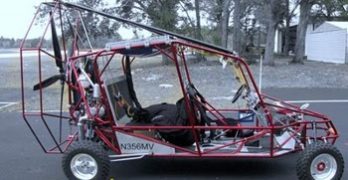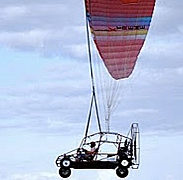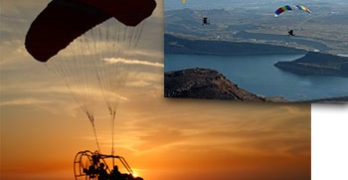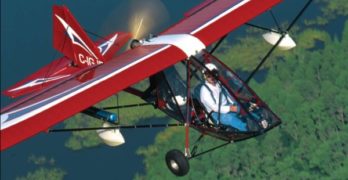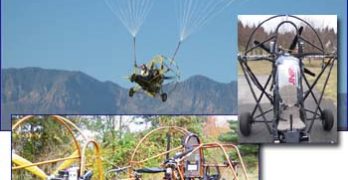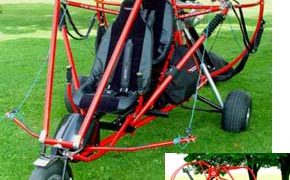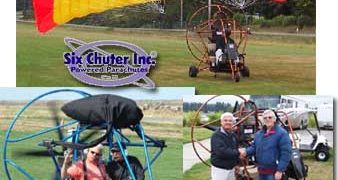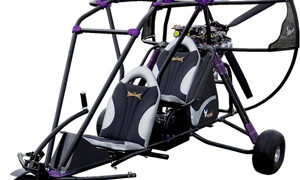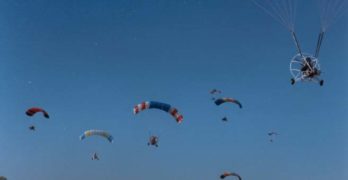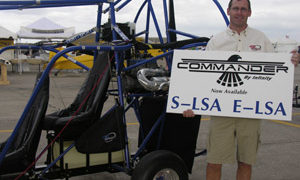Gang, with all the excellent publicity the Terrafugia Transition “roadable” LSA airplane has gotten this last year or so, you’d think they were the only game in town. *** Meanwhile, back at flying car HQ, here comes the sleeper, with some important news under its (canvas) hood. *** I’ve blogged about the Maverick Flying Car a couple times now (read earlier post). *** It’s a project created by I-Tec in their mission to aid third world indigenous people in remote and rugged locales around the world. *** To paraphrase Luke Skywalker, if the Transition is the bright promotional center of the universe, the Maverick has been the planet farthest from it…until now. *** They’ve been quietly, and quite effectively, judging by the video below, getting the job done with their own unique approach to the flying car concept. *** Without further ado, check out the vid below of the Maverick LSA…Para-buggy, Para-Car, Dune-Chute, whatever.
Flying Missionary Car Now Street Legal
Since everybody seems to be talking these days about flying cars, specifically the Terrafugia (the company excels at promoting its Transition model, which recently got a weight allowance boost from FAA), I thought I’d update my earlier post about the I-TEC Maverick Sport Model. *** It’s a cool idea, this flying car developed for missionary work in third-world countries like the Amazon rainforest, where getting from village to village can be daunting to impossible for traditional vehicles. *** Instead of folding wings, it uses a paraglider-style canopy for lift. I-TEC (Indigenous People’s Technology and Education Center) spent seven years in development. I talked with one of the I-TECcies at Sun ‘n Fun 2010 and they’re pretty proud of this compact, relatively inexpensive vehicle. *** Changing from road warrior to sky king takes just a few minutes. Once rigged, the fabric-fuselage Maverick lifts off in 250 feet, climbs at 500 feet per minute, and rips along at just under 40 knots.
Predator Powered Parachute… & Immersion Training
Another one managed to slip by my radar. I follow LSA closer than most yet I can barely keep track of all the approvals. No wonder I frequently get calls asking me to unravel the puzzle of LSA makes and models. *** Better late than never, welcome the Predator powered parachute to our SLSA List of 108 models from 72 still-active companies (at least five have left the business). Scott Hughes is the original designer & creator of the Predator. *** New CEO Fredrick Scheffel wrote, “On April 22, 2009, SkyTrails LSA (Predator Powered Parachute LLC) purchased the rights to manufacture the Predator along with the tooling & inventory from Hughes Aero.” SkyTrails LSA moved into the hangar facilities where Hughes Aero had been building the Predator for the past four years. Scheffel further noted, “SkyTrails Ranch, Inc., is a long standing name in powered parachute training, sales, and service that [has now] expanded into powered parachute manufacturing.” *** National powered parachute expert, Roy Beisswenger confirmed the Predator as a Special LSA, “SkyTrails LSA is manufacturing ELSA & SLSA aircraft at the airport in Wharton, Texas.” *** Learning to fly a powered parachute can be challenging.
Lightplane Offerings From Canada
The Beaver and Chinook ultralight-like aircraft are arguably two of the bestknown
lightweight designs coming from Canada. Aircraft Sales and Parts, more
commonly known as ASAP, is the company that rescued and now manufactures
and sells these designs, along with a powered parachute from its sister company,
Summit Powered Parachutes. The tale of ASAP’s involvement with the Chinook
and Beaver offers insight into ultralight progress – Canadian style.
A History Lesson
Perhaps the most famous ultralight
to come out of Canada is the Beaver.
With a reported 2,200 flying units
since the early 1980s, it’s a successful
design. However, due to corporate
missteps by the companies that
owned the brand, the Beaver series
was nearly lost. Originally, the Beaver
models were manufactured by
Spectrum Aircraft Inc. Reorganization
left the ultralight in the hands
of a company called Beaver RX Enterprises.
In 1993, that company closed
its doors and stranded thousands of
Beaver aircraft owners, along with
all the dealerships that sold and serviced
them.
Hat Trick: 3 Six Chuter Powered Parachute SLSA
Six Chuter marketing man, Doug Maas, figures it’s like soccer where three goals in a game makes a “hat trick.” With their third model gaining SLSA airworthiness before the January 31 deadline for ultralight conversions, the Washington company has earned the sports phrase. The powered parachute (PPC) producer’s newest approvals brings the total to 75 SLSA models…in less than three years! *** Boss and designer Dan Bailey planned to create three models based on common airframes. Consequently, Six Chuter has the market covered like, uh…well, like a parachute canopy. They have a “conventional” tandem (Legend XL); a rare side-by-side PPC (XT SSDC), intended as a trainer appealing to instructors who want to be alongside their student; a single seat SLSA (P103); and a Part 103 qualifier (P103UL), when flown with the Rotax 503 and few accessories. The mainline PPC Legend was derived from Six Chuter’s SR7 and Spirit models but all were redone to fully address the Light-Sport Aircraft rule.
Soaring Concepts Powered Parachute Earns SLSA #59
Sometimes it seems like all the attention is focused on fixed wing Special Light-Sport Aircraft. This makes some sense as they represent the majority, about 80% of all types. Still, you can’t ignore weight shift trike producers and those working to achieve airworthiness for powered parachutes. After a slow start, we now have 6 trike models approved as SLSA (and I’m waiting for verification on 2 more) plus we have 5 powered parachute models. Sales of non-fixed wing aircraft account for more than 21% of all SLSA registered with FAA with powered parachutes representing a quarter of this one-fifth share. *** Soaring Concepts president Galen Geigley reported his fresh airworthiness certificate was granted October 3rd, becoming model number 59 to earn approval. The company was founded in 2000 and in 2006, their Sky Trek won Reserve Grand Champion from AirVenture judges. Priding themselves on a well equipped aircraft, the 2007 Sky Trek SLSA is available with “leather illusion seats that gives you the premium look of leather with UV protection.”
Six Chuter Powered Parachutes Joins the LSA Parade
As the deadline approaches for ultralights needing to convert to LSA, companies are recognizing the need to get products ready for the new age of light-sport. The latest: Six Chuter, one of the original producers of powered parachutes…but one that took their time hopping on the bandwagon. *** Director of Communications, Doug Maas (who also completed the production test flight), reports the company developed more than 1,000 pages of documentation to meet ASTM standards. The voluminous information came from creating a brand-new carriage with multiple configurations. Legend (which is SLSA #58) can be a single seater, tandem seater, or a somewhat rare side-by-side powered parachute (photo). This is a novel approach to certification and explains the delay for the company’s SLSA entry. Six Chuter said, “The Legend XT SSDC (Side-by-Side Dual Control) is our SLSA development model targeted for flight instructors and others who enjoy a side-by-side configuration.” Six Chuter will offer the XT SSDC and other models as either fully-built SLSA or as ELSA kits.
SLSA Number 50 Is Powrachute’s AirWolf 912
Right at the two year point since the first Special Light-Sport Aircraft approval, Powrachute’s AirWolf 912 powered parachute brings the certified fleet total to 50 SLSA models. Forty two of them are airplanes (the fixed wing variety) with five being weight shift (trikes), and three powered parachutes. Among PPCs, the Canadian Summit II was first in 2006 followed by Infinity’s Commander early this year. *** Team Powrachute loads up their AirWolf 912 with the electric start 100-hp Rotax, a four-blade Warp Drive composite prop with Super Hub, an Electronic Info System with instrument pod, extended footbars, spun aluminum wheels, tundra tires, dual hydraulic main gear suspension paired with springs, stainless exhaust, strobe light, electric fuel pump, dry cell battery, four-point seat belts, oversize canopy carry bag with line socks and a choice of parachute sizes and colors. While some complain about the cost of LSA, here’s one with a four-stroke engine for less than $31,000.
Powrachutes on the Prairie
Only three weeks earlier, our nation had endured wrenching emotion from the September 11 attacks. But life must go on.
So Powrachute of Columbus, Kansas, went on with its third annual Extravaganza. One look at the grounds promised that this was to be no ordinary company fly-in. Most of them resemble a family picnic; this one looked like an airshow.
For the 2001 Extravaganza, Powrachute reported an attendance of 5000 spectators. Greeting them in this year of uncertainty was a beautifully airbrushed bald eagle against an American flag backdrop. The art took up 15,600 square feet of the flying field.
Mass Launch
Extravaganza participants came from 29 states plus Canada, and they brought 215 aircraft. Much like the giant hot-air balloon fiesta in Albuquerque, New Mexico, the Powrachute gathering provided a great photo opportunity to capture the large and colorful wings of aviation’s newest segment.
On one occasion during the four-day event, a launch of powered parachutes put 80 of them in the air in 20 minutes.
Second Powered Parachute Approval Goes to Infinity
December is a quiet period for many businesses, unless they are involved with consumer retail. It was the first month in 18 that reported no new SLSA. But the Sebring Expo evidently proved to be a motivator as we had no less than four announcements at the show. *** Infinity Power Parachutes of Sturgis, Michigan proudly showed their Commander SE 582 two seater that earned SLSA #45. This represents powered parachute approval #2 and is the first American PPC to win its airworthiness certificate. Commander has altered the structure from my earlier Infinity 2001 report but retains the dual three-inch angle beam structure that provides exceptional strength to Infinity models. Commander’s carriage also continues the flexibility of frontal safety bars as a removable option; primary structure is not affected. Commander 582 has sold for $15,000 but the cost of earning SLSA approval is certain to increase the price.


